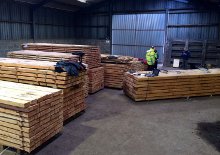Larch makes the grade
5 April 2014Research work could help lead to a new wave of engineered wood products in Scottish larch. Stephen Powney reports.
Across the UK the Phytophthora ramorum tree disease has been cutting swathes through the larch population.
Forestry Commission efforts to control the outbreak's spread have led to large numbers of fellings in the affected areas, with some significant volumes of timber now coming onto the market.
Wales and the south-west of England have suffered from outbreaks but Scotland is also hit by the disease. Around two million tonnes of larch are estimated to be affected in southern Scotland.
Work to find value-added uses for this timber is continuing apace, with Edinburgh Napier University, the Forestry Commission and the timber industry involved in research and product development.
The Wood Product Innovation Gateway, funded by Scottish Enterprise, Forestry Commission Scotland, Wood for Good and Confor, is working hard researching Scottish larch, including looking at its use as an engineered wood product.
"If you are using it structurally you need grader settings," said Andy Leitch, gateway manager and timber development policy adviser at Forestry Commission Scotland.
Mr Leitch said agreed settings for bending graders existed, but some of the mills now had X-ray and acoustic grading systems.
"We need to get a lot of data and break a lot of pieces of wood," he added.
He said Napier's work on the settings was continuing and he hoped the European grading committee could sign them off this autumn so the industry could use them next year.
A timber markets impact group, involving public and private sector representatives, is also looking at how larch can be used.
Converting larch trees into useable timber is not as straight forward as Sitka spruce.
Scottish larch trees do not have the same form and shape as spruce. They are not as straight and have a smaller girth.
"When you fell it, a lot more smaller wood sections are created," said Mr Leitch.
With about two million green tonnes of spruce, sawmillers would expect to convert roughly 50% into sawn timber, whereas with larch it could be as low as 30%.
"You would not get anywhere near as many 4.8m lengths from larch as you would Sitka spruce. But it is a denser timber and you can get higher strength grades from it." Existing grading done with bending graders shows it can reach C18 strength, but research is also looking at higher grades.
"We are putting as much information as we can into the hands of the industry," said Mr Leitch.
Larch potential
Engineered larch applications being looked at include cladding, finger-jointed timber, closed timber frame panels, glulam, cross-laminated timber, a dowel-laminated timber system and open-web joists.
Glenalmond Timber Company is one of several companies working with Napier to develop products with the material. Its fingerjointed Scottish larch was launched at the recent Ecobuild show in London.
"We were inundated with people interested in our range of finger-jointed timbers as we can defect cut in line, only removing the non conforming product thereby utilising more from each board which we then supply in any length up to 12m removing all waste on site, unsightly butt joints and offer a very high quality aesthetic," said Mr Steele.
He reported 109 enquiries for the products, with many taking finger-jointed Scottish larch samples in particular away to show to clients.
"Finger-jointing also enables us to use other native species such as FSC English sweet chestnut and oak. Some species breach quite low on the tree so you do not get high quality, long, solid lengths required for cladding applications.
"However, we can still use these short lengths through finger-jointing, thereby increasing the yield and improving access to these native high-value species now fit for modern construction applications."
The company has finger-jointed larch for a while, but it sees many more opportunities ahead with the increasing availability of the raw material.
He said it was difficult to find a homegrown alternative that could compete toe-totoe with imported product on performance and aesthetics and didn't add a lot of cost through the engineering process which would negatively affect its commercial viability.
"It's British, its local and its FSC," added Mr Steele. "It's a win-win for UK fibre."
Finger-jointed applications
As well as exploring cladding, Mr Steele has been looking at the use of finger-jointed larch for decking, bridges, C24 and C27 structural sections and even the flanges on metal-web joists, where the species' superior stiffness to pine or spruce is potentially advantageous.
Mr Steele believes that a significant volume of larch will become available if ramorum spreads north of Perth.
"We are trying to develop a value-added market for it now, that will run alongside the traditional larch products such as pallet wood and fence posts," he said.
Robert Hairstans, head of Napier's Centre for Offsite Construction and Innovative Structures, said the research work was moving on from initial work to a more wide-ranging project examining Scottish larch's properties to inform the potential for value-added and engineered products.
"People have a knowledge of the material and we know its attributes in terms of durability," said Mr Hairstans. "But if you are looking at the volumes coming on stream then that needs to have quality assurance and that has to look at the grading of the material and how you set up the grading."
